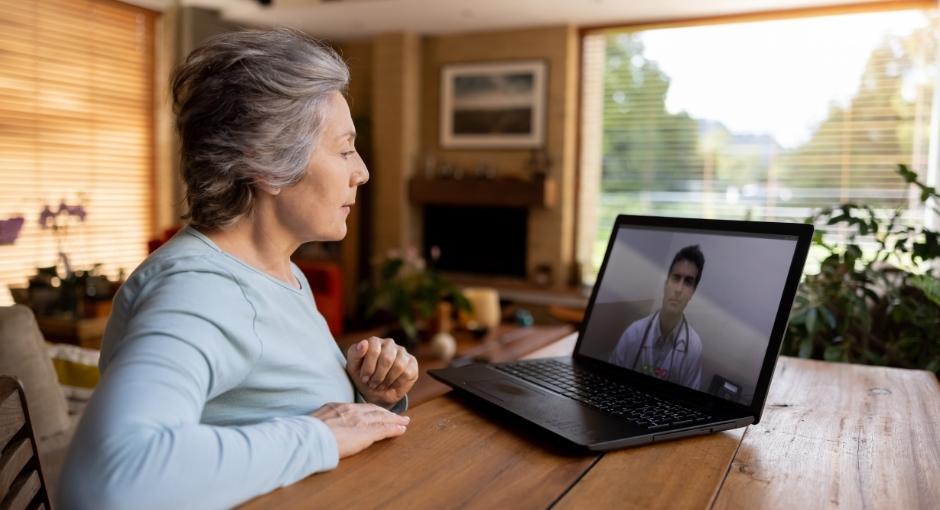Telemedicine
💡 Quick Summary
-
Telemedicine offers convenient expert Parkinson’s care from home and is as effective as in-person visits for most symptoms and treatment adjustments.
-
Virtual appointments reduce travel time, support people with fatigue and expand access to specialists.
-
Preparing ahead with symptom notes, medication lists and basic tech setup helps you get the most out of telehealth visits.

Telehealth or telemedicine is when healthcare providers deliver health-related services and information using technology. Telemedicine appointments are becoming an ever-increasing part of healthcare.
Studies show that care delivered through telemedicine is as good as care delivered at a medical center. In fact, some people prefer telemedicine appointments because they feel more at ease in the comfort of their own home.
Reasons to Use Telemedicine
Virtual appointments are convenient, allowing people at any stage of Parkinson’s disease (PD) to meet with their doctor from anywhere using a smartphone, tablet or computer with internet access. Through telemedicine, a movement disorder specialist (neurologists with additional training in Parkinson's) can treat and address most Parkinson’s symptoms, adjust medications, assess the disease’s progression and recommend additional therapies.
According to a Parkinson's Foundation COVID-19 survey, 46% of people who started using telehealth during the pandemic hope to have this option in the future — indicating that telehealth may be a great complement to in-person care.
Benefits of telemedicine include:
- No need to arrange transportation
- Less time spent going to and from appointments and in waiting rooms
- Helps those struggling with fatigue
- Reduces exposure to other people's germs and viruses
- More casual than the doctor's office
- Helps providers assess home safety and make changes in real-time
- Provides access to specialists not available locally
Types of Appointments
While telemedicine can never fully replace all the benefits of in-person appointments, telemedicine appointments can be made for almost any type of medical appointment.
Physical therapy, occupational therapy, speech therapy, mental health services and some neurology appointments are just a few examples of appointments that can be done virtually.
In most cases, the health professional will rely on video in addition to audio to properly conduct the appointment, requiring a strong internet connection.
Of course, there may be instances where specific tests or appointments need to be done in person. Discuss with your doctor what can be done virtually and in person. If you have a deep brain stimulation (DBS) system, it may have a feature that allows your physician to perform tests and routine check-ups and adjust levels to treat symptoms without requiring a hospital visit. Ask your physician if this is possible for your DBS system.
Preparing for a Telemedicine Appointment
These 10 tips can help you prepare for your next telemedicine appointment:
- Get ready. Prepare a list of questions and symptoms before your appointment. Consider inviting a family member or friend to help take notes and for extra support.
- Review medication. Check to see if you have enough pills at home or if you need refills. Make a list of all of your medications for Parkinson’s and for other conditions. Download a medication form.
- Download communication software. Ask your healthcare provider which video platform or application you will need to download ahead of time.
- Check technology. Make sure you have a good internet connection. Charge your device before the appointment or try to keep it plugged in.
- Be ready to move. Give yourself room to move. For instance, your movement disorder specialist or physical therapist might ask you to walk or perform another task.
- Gather your tools. Have paper and a pen nearby, along with any items your healthcare specialist may have asked you to bring to your appointment (thermometer, scale, medication bottles, etc.).
- Prepare your space: silence your phone, limit clutter and background noise.
- Take notes. For future reference, write down any important information or suggestions your health care provider shares with you.
- Provide updates. Let the doctor’s office know if your pharmacy, insurance or contact information has changed.
- Talk about follow-up care. Schedule your next appointment if possible.
Participating in Telemedicine without a Computer or WiFi
There may be ways to get the necessary care if you do not have access to a computer or WiFi. A smartphone with video capability can be used to meet virtually with your doctor. You will need to prop up and stabilize your phone so that your doctor can see you properly.
If you do not have access to a computer or a smartphone, contact your local Area Agency on Aging and ask if they have computers or tablets you can use. You can find the nearest location by calling 1-800-677-1116. You can also call 2-1-1 and ask for resource suggestions.
Related Materials
Related Blog Posts

Celebrating 12 Milestones that Defined 2025

Meet a Researcher Working to Make Adaptive DBS More Effective
